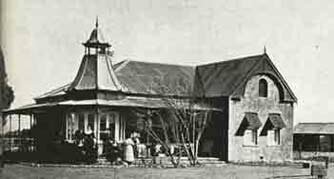Vaal Triangle History
1889 - 1902
Sharpeville
Klip Power Station
William Stow
Coal
Vereeniging
1960
1939 - 1945
Peace Negotiations
Viljoensdrift
1935
Riviera Hotel
Vereeniging History
As early as 1895, a Miss Lester had run a private school in the village. At the time it was considered inadequate for the number of children residing in the town and a local school committee was formed to approach the resident Justice of the Peace, J. S. N. Hugo, to secure from the Transvaal Government a site for a suitable schoolhouse. The mining company contributed £250 towards the project and promised further annual grants. However, it was only after the war that a permanent public school was established in Vereeniging.
Before the war had ended the district commissioner, Captain Bentinck, co-opted Leslie to form a health service and the two men constituted themselves as a sanitary committee. Bentinck retained health control of the military establishment and Leslie assumed control of health for the civilian population. A system of hygiene was imposed on the inmates of the concentration camps as well as on the inhabitants of the village.
In January, 1902, in terms of Government Gazette No. 5 of 1902, the Colonial Secretary of the Transvaal appointed a Board to assume control of the town's health services. The members were: E. T. Baines, assistant resident magistrate, chairman; T. N. Leslie, builder; E. M. Goodwin, mine manager; A. Evens, schoolmaster; I. Hughes, hotel keeper.
This was the first move towards the reinstatement of civil government. Bentinck issued a proclamation which detailed the charges the Health Board would levy for sanitary services, stipulating that the board "must not clear military buckets or rubbish without being paid for the service". Bentinck handed over to Leslie the 'sanitary committee's' bank account and cash which Leslie in turn lodged with the Board's chairman, the assistant magistrate. In taking over the committee's assets and liabilities the Board acquired a credit balance of £23.1s.6d.
In the camp families lived in tents only a few feet apart. They were unaccustomed to living under any kind of 'urban' conditions and the hygiene required was unknown to them. Some inmates persisted in applying ineffectual 'remedies' for their ailments because of their inherent mistrust of medicaments outside the range of the old Dutch medicines they had known for generations.
During the war, the colliery's schoolmaster, A. Evens, held classes in the concentration camp for the children interned there and for the children of the village who had not fled with their parents. Since the days before the war, Evens had conducted classes in a schoolhouse situated near the Grand Hotel and the Vereeniging railway station. Then when


